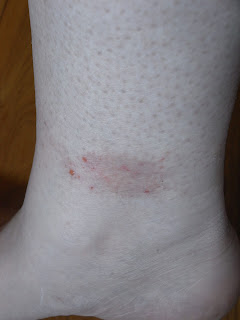 In my previous post I spoke about my Cobalt allergy,
In my previous post I spoke about my Cobalt allergy,I am also allergic to Rosin (AKA colophony.)
Rosin is the sap from pine and spruce trees,
it is used to produce turpentine oil and colophony.
There are 3 types of colophony, gum wood and tall oil.
The only treatment for this allergy is avoidance
& as Colophony is found in so many everyday
products, it can prove difficult to avoid.
The photo to the right shows a reaction I
had to the glue on the seam of a pair of ankle boots,
I have had it for quite a few months now.
I have to be careful when I buy shoes that have
seams as they usually use glue as well as stitching
I also ended up with a red itchy band around my
ankles from the rubbery elastic in a pair of socks once
Other names for colophony are:
Abietic acid/alcohol, Abitol colophony,
Abietyl alcohol, Dertomal 18, Dercolyte ZS,
Methyl abietate alcohol, Dertophene 18,
Foral 105, Gum rosin, Granolite SG,
Hercolyn D, rosin, rosin tall oil, staybelite10,
terebinthinate, W-W wood
Colophony are found in the following items:
• Adhesives, such as sticking plasters, stamps, tapes & glues
* Ashphalt products
* Brewery pitch
*Caulking compound
• Cements for linoleum, rubber, shoes, lens coating
• Chewing gum
• Cleaners for machines, leather and removing grease from clothes, pine oil cleaners
* Clothing (prewashes, tackifier
• Cosmetics eg eyeshadow, lipsticks, mascara, rouge, hair pomade and transparent soaps, sunscreens
• Dental floss, Dental cements and impression pastes
• Depilating (hair-pull wax) agent
• Diapers, incontinence pads & feminine hygiene products
• Disinfectants and insecticides
• Fireworks
• Floor coverings (adhesive) e.g. linoleum
• Glues eg postage stamps
• Grease (axle) and lubricants
*Inks (ceramic, marking pens, printing)
*Insulation tape (electrical and thermal insulating tape)
*Jointing tape• Match Tip
• Medicaments – as a preservative, adds adhesive properties to ointments and creams e.g. wart removers, nappy creams, cold sore cream, (disinfectants,insecticides, preservatives
*Modelling clay
* Nail polish
• Newspaper
* Oils (core oil, cutting oil, tall oil)
• Ostomy appliance
• Paints
• Paper Products (largest single use) – adds water resistance, glossy paper, photographic paper, can labels, toilet paper
• Pens – felt tip & artist pens
• Polish for floors, furniture, shoes and cars, coffee beans
• Polythene (polyethylene)
• Printing – inks, paper & photograph
• Resins eg epoxy resin, those used for musical instruments
• Rubber – synthetic, neoprene
• Sawdust and resins of pine and spruce and wood fillers
• Sealants
• Shoes (adhesives) and clothing
* soaps
• Soldering fluxes and soldering agents
• Solvents
• Stains
• Surface coatings eg price labels, rust-proofing,
• Tacky substances – to prevent slipping eg athletic grips, sports handles (golf, tennis)
• Varnishes
• Waterproofing agents eg. Cardboard
• Waxes
I've found that I am allergic to makeup and shampoo/ conditioner, I avoid anything that has a sparkly/opalescent look, I also stopped dyeing my hair.
Feminine hygiene products proved difficult, especially when i was menstruating every fortnight which was for about 5 years,
luckily I don't have to worry about that anymore.
Stress also makes the problem worse, so de-stressing techniques can be beneficial.
My advice would be to have an allergen test if you suspect an allergy that way you can avoid the allergen and can possibly prevent hypersensitivity.

My goodness you poor thing! It's found in so many everyday products!I looked through your list to see if knitting/crocheting yarns were there. Now that would have been devastating for you! Did you gradually develop these allergies or have you had problems all your life? I've heard of people who have had to make huge life changes as they were allergic to 'modern life'...big upheavals to try to be healthy.
ReplyDelete